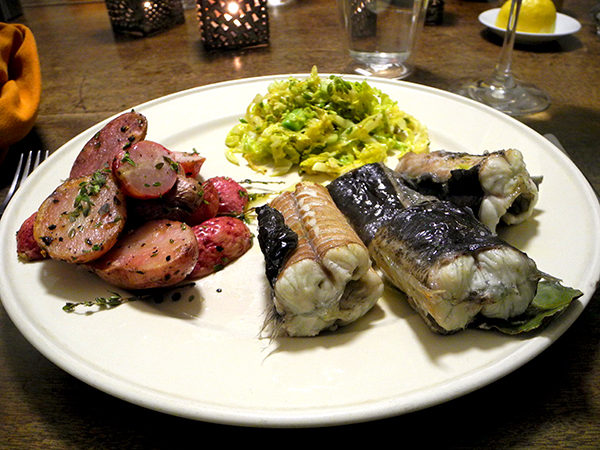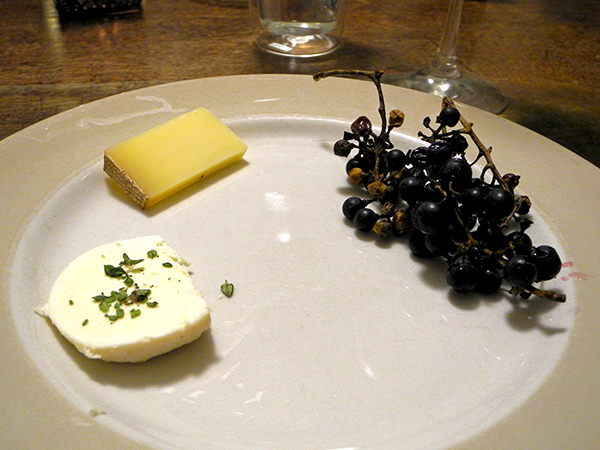No one should have to wait to enjoy eel until christmas, especially if she or he isn’t really Italian, and doesn’t believe in christmas. I was almost beside myself when I spotted eel at the Pura Vida Fisheries stand in the Union Square Greenmarket today. It had been so long since I had last prepared it at home that, as I learned later, that it didn’t show up in this, my more-than six-year-old food blog. I had already picked up a bag of very fresh shrimp from Eco Shrimp Garden, some one hundred feet north of the shallow bucket of eel, but I was quickly reassured by all parties involved in my [gentleman’s] fishing expedition in the Greenmarket that the shrimp, perhaps more so than the eel, could wait another day.
In the past when I had cooked eel, I had stressed out over how I would prepare this exceptional fish, but I decided this time early on that I would go for the simplest preparation possible. That meant Antonio and Priscilla Carluccio’s version of ‘Anguilla alla Luciana, a recipe from Naples (thus explaining the meal’s wine pairing) which appears in what I consider the absolutely indispensable, ‘Carluccio’s Complete Italian Food‘. Of course my decision was not in the least prejudiced by my fulsome affection for bay leaves in virtually any application.
Although I might have liked to finally use the ancient Rhode Island eel fork leaning in the corner by our table to catch it, modern urban civilization [New York City] meant that it wasn’t necessary. My fish dealer had also skinned and cleaned the Anguilliform, an immensely valuable service, from what I understand.
The fish was incredibly delicious (and, for those who might still be wondering, there was absolutely no yuck or yecch quotient).
- a one-pound skinned and cleaned eel From Pura Vida Fisheries,, cut into three-inch segments and placed, or layered, inside a ceramic baking dish, accompanied by a large number of [ideally fresh] bay leaves and sprinklings of sea salt, placed in a hot, 400º oven for about 30 to 40 minutes, then removed and drizzled with a very little bit of fresh lemon juice and a bit more olive oil
- a few small red new potatoes from Norwich Meadows Farm and a handful of very red radishes, also from Norwich Meadows Farm, each one halved, tossed in olive oil, salt, pepper, and sprigs of thyme from Phillips Farm, roasted on a ceramic pan for about 30 minutes, removed and sprinkled with more (now chopped) thyme leaves
- one very small San Michele cabbage (an Italian Savoy) from Tamarack Hollow Farm, sliced fairly thinly, sautéed in olive oil along with segments of one very small leek from Ryder Farm, removed from the heat, seasoned with salt and pepper and tossed with fresh fennel seeds from Lani’s Farm
- the wine was an Italian (Campania) white, Falanghina Feudi di San Gregorio 2014
- the music was from the Harmonia Mundi album, ‘Venezia 1625‘
There was also a cheese and fruit course, with its own twist. It was not the cheese that was out of the ordinary, at least for me, but the fruit, which I was told by Richard Giles, the Delaware County farmer, was a wild New York grape, one which had not yet learned to be sweet, but they were sure pretty. For anyone interested in such things, each grape contained a single (normal-size seed); it wasn’t a problem for me, because I alway eat the seeds, even though, until today, I did not know that they were very good for you.
- ‘Rupert’ cow cheese from Consider Bardwell Farm
- ‘Brebis Blanc’ soft (but now hardening) sheep cheese from 3-Corner Field Farm, sprinkled with some chopped thyme from Phillips Farm, the herb remaining from the roasted vegetables
- tiny wild black grapes form Lucky Dog Organic Farm


